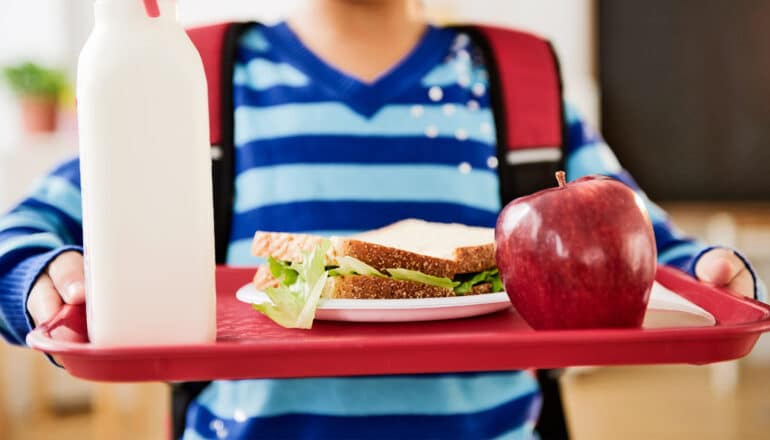
A new study found that children improved their diet quality when they ate school-prepared lunches following the Healthy, Hunger-Free Kids Act nutritional guidelines instead of home-prepared lunches.
Lower-income and non-Hispanic Black students saw the most significant improvement.
“It was very clear that across the board that the overall quality of kids’ diets improves when they eat a school meal,” says Travis Smith, associate professor in the University of Georgia agricultural and applied economics department and lead author of the study in the American Journal of Preventive Medicine.
The study population included more than 13,000 schoolchildren. Researchers reviewed two dietary intake diary entries per child including at-home and at-school meals to analyze diet quality. They compared Healthy Eating Index scores, a 0 to 100 score that measures adherence to nutritional guidelines, for students from before and after HHFKA’s 2012 implementation. Healthy Eating Index (HEI) improvements were seen across the board.
“We found that if all children were to eat a school meal versus an at-home meal, the disparity in their Healthy Eating Index goes away,” Smith says.
All students improved their HEI scores, and students from low-income households saw a 10.34% increase over at-home dietary scores. The largest improvement, however, was among non-Hispanic Black students. They saw a 16% increase in their healthy eating scores over at-home scores, which Smith says relates to baseline diet as well as the benefit of school lunches.
“The increase in HEI points for non-Hispanic Black students and students that live in lower income households is higher, but the baseline they’re coming from for at-home diet quality is also lower,” Smith says. “That’s why you get such a big jump. You have a higher increase from a relatively lower base.”
An increase in whole grains was the largest contributor to a healthier diet, and a decrease in saturated fat intake was a close second.
“Prior to HHFKA, school food used to contribute negatively to whole grain consumption because kids would eat refined grains instead of whole grains,” Smith says. “But when the act went into full implementation in 2013, it led to more than a one-point bump in HEI.”
While school nutritional guidelines used to come up once every five years as part of the Child Nutrition Reauthorization Act, it has not been wholesale updated since HHFKA’s first approval in 2010. Instead of sweeping changes, there have been minor patchwork tweaks year over year, Smith says.
For example, in 2010, if 40% of schoolchildren in a district were eligible for free meals, then schools could offer free meals to all students. In 2023, however, that threshold was lowered to 25%. This is an example of an overall trend, Smith says, and indicates where these guidelines are moving.
“The direction they’re going is to continually make the food healthier and then make it more widely available and easier for kids to sign up for free meals,” Smith says. “Right now, there’s a whole stigma, where students think their free meals are a sign to peers that they are low income. But when you open meals up to all kids, that stigma starts to go away.”
This has been shown in other studies, where school lunch participation increases across the board, no matter income level, if lunch is free for all students.
And in some cases, states are taking matters into their own hands. Eight states have already implemented free-lunch-for-all policies, but those changes do not always align with the groups with the most significant need, Smith says.
“The states that opt into doing this are probably already more financially secure,” Smith says. “So if you have a state that doesn’t have the money to implement this policy, it’s probably the one that needs it the most. And that’s why the federal government—and this is just my opinion—should step in and why some states are trying to get ahead of it and doing it on their own.”
Smith hopes this study highlights the benefit of school lunch availability and the importance of nutritional guidelines.
“When we put all this together, this is showing that offering free meals to everybody is a good idea,” Smith says. “It’s not going to be harmful, and even higher income students benefit from these policies.”
Source: University of Georgia
The post Diet quality goes up when kids eat school lunches appeared first on Futurity.
from Futurity https://ift.tt/deP5wcD
No comments:
Post a Comment